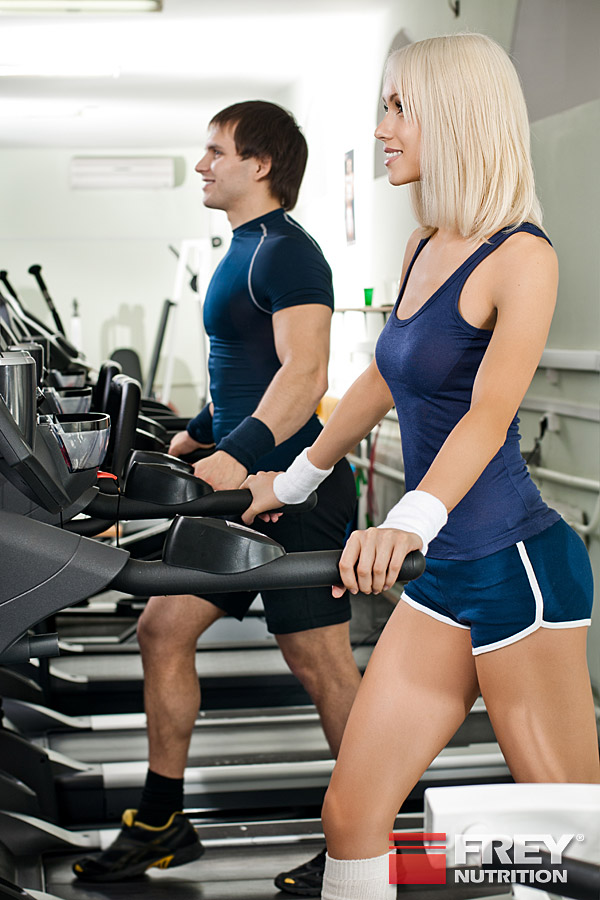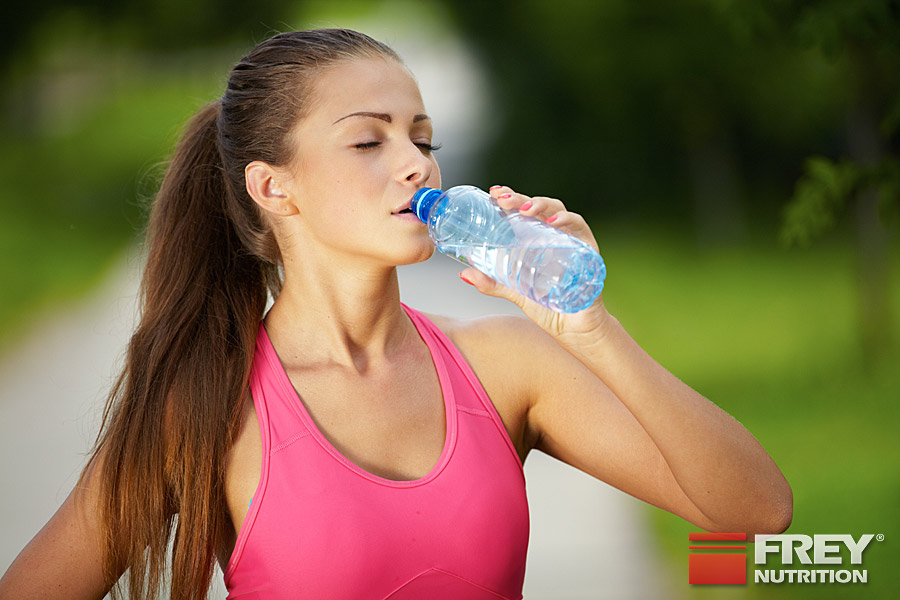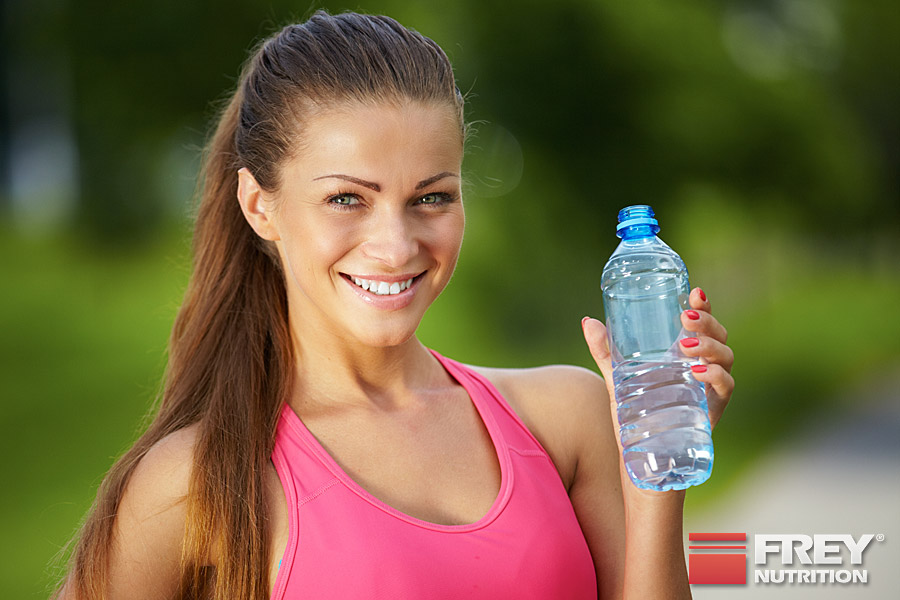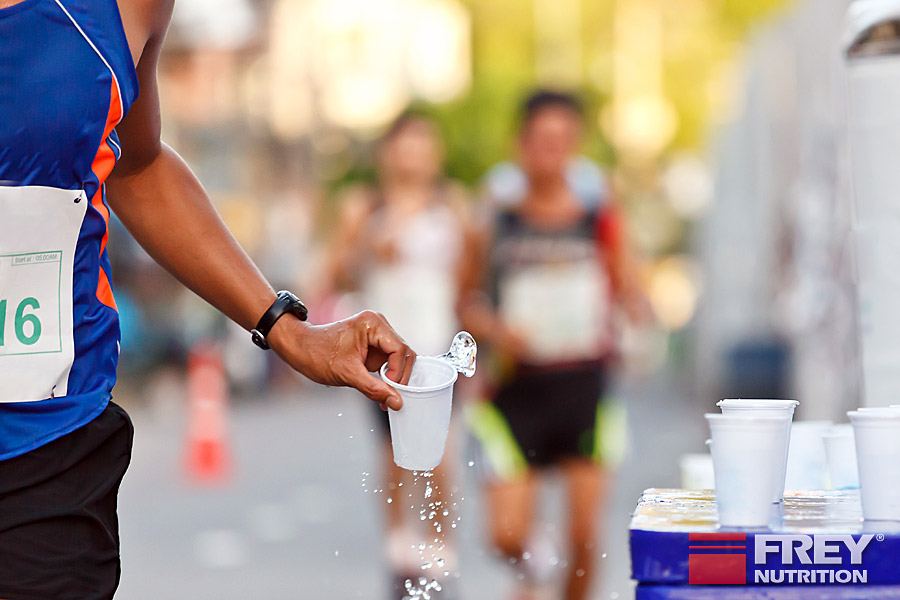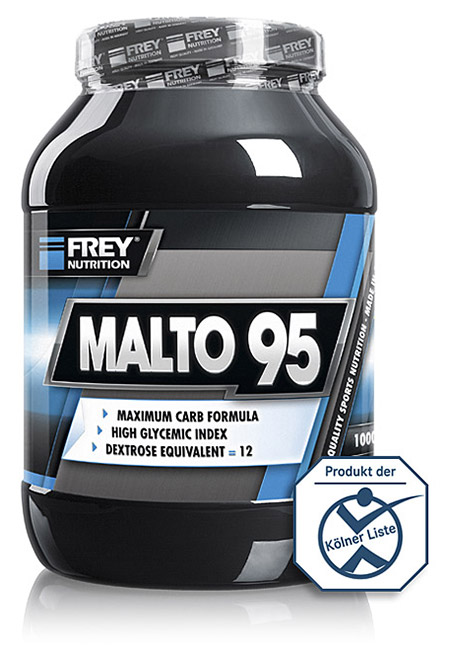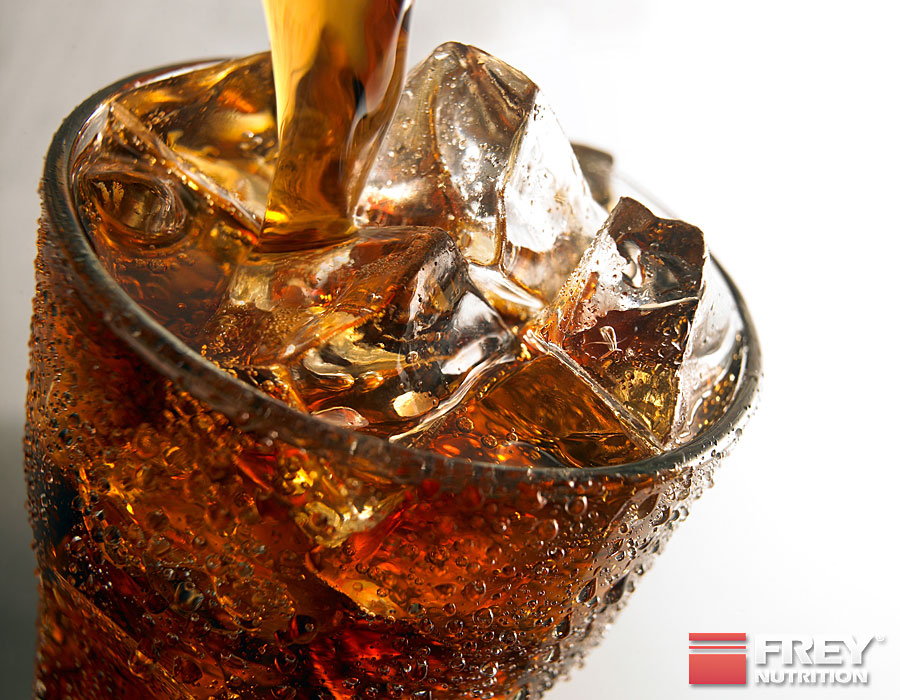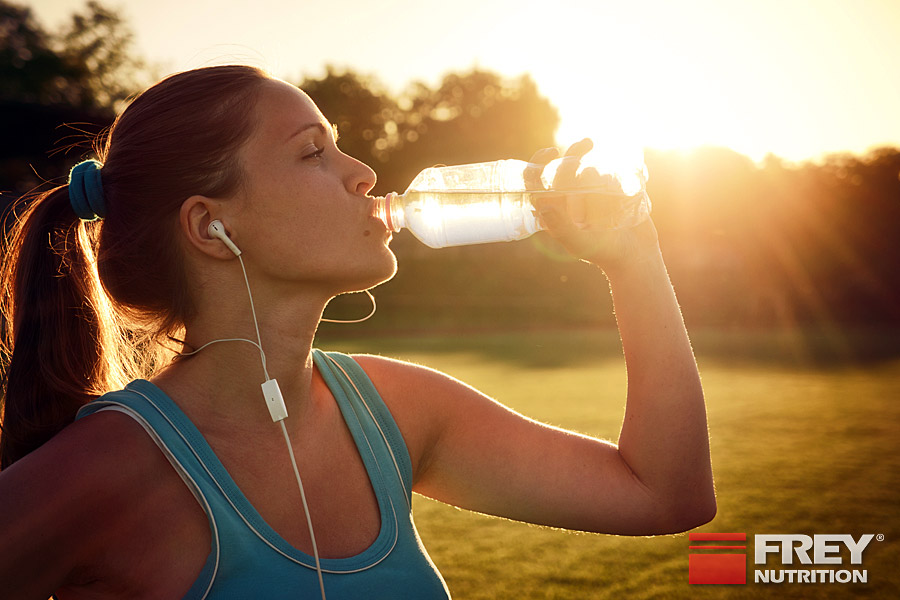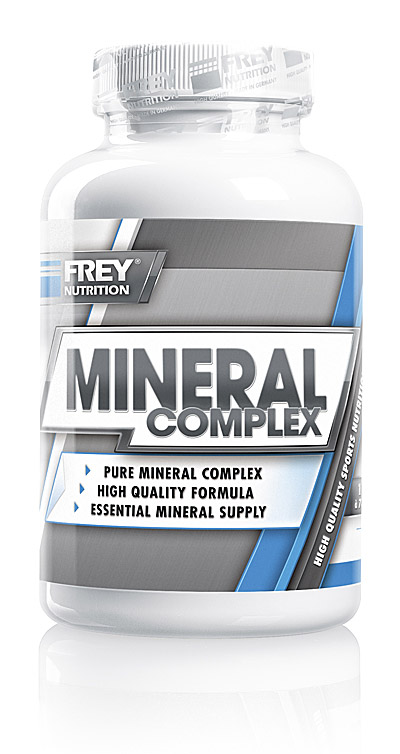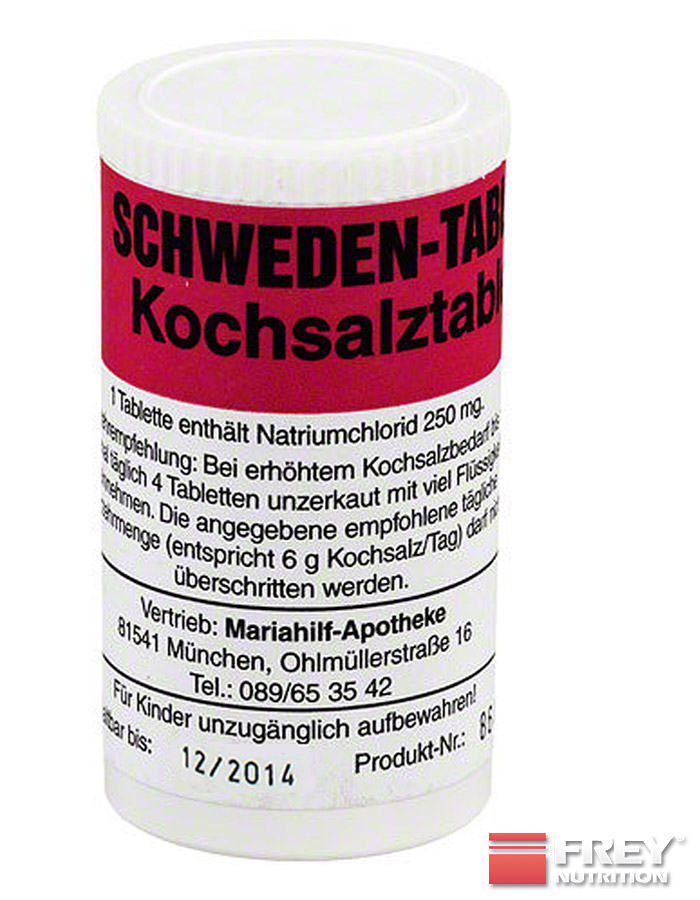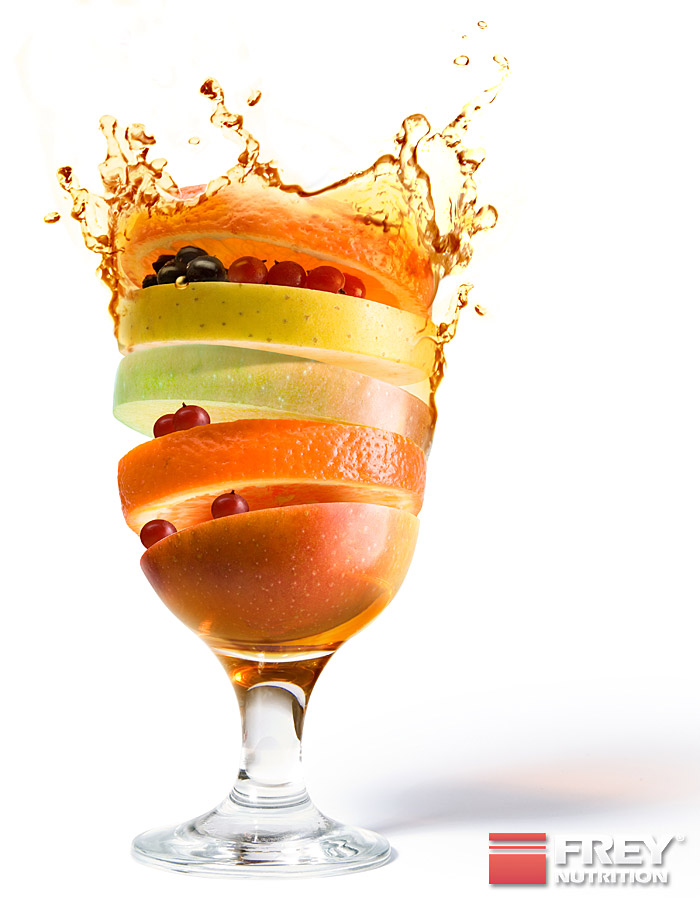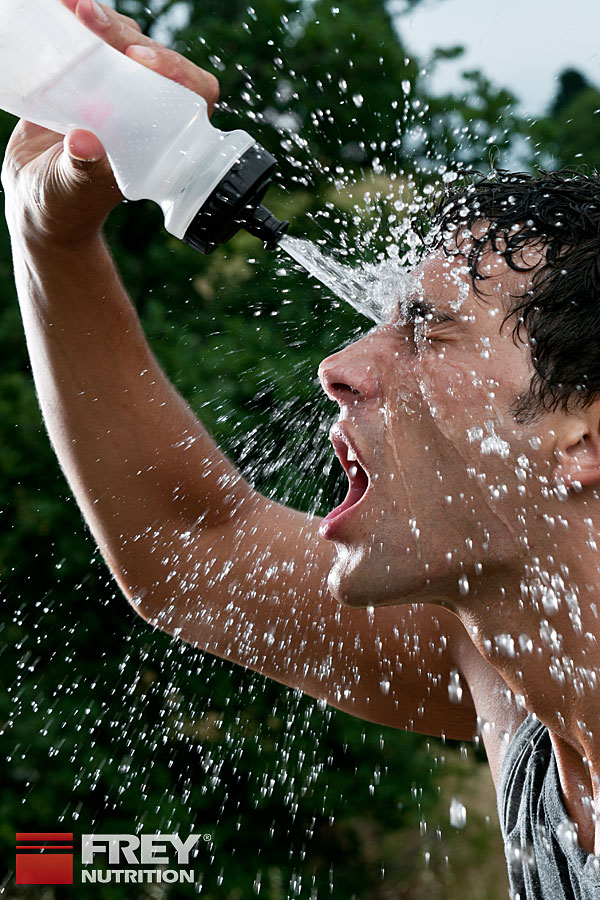WHY SUFFICIENCY FLUIDS ARE IMPORTANT!
When muscles work, chemical energy (ATP) is converted into mechanical energy and heat. The efficiency of muscles is relatively low at around 25%, and the remaining energy is "lost" as heat: when we move physically, we get warm. During intense physical activity, the body is forced to release the heat generated to the outside through sweat in order to avoid overheating the organism (excessive increase in core body temperature), which is harmful to health.
IF YOU HAVE GOOD ENDURANCE TRAINING, YOU CAN ALSO SWEAT WELL.
So anyone who does sport sweats. Sweating does not have to be a sign of poor fitness, on the contrary: anyone who is well trained for endurance can also sweat well. Sweating is necessary for the body's heat regulation so that the core body temperature does not rise to a dangerous level, which could lead to heat stroke. The importance of releasing heat most effectively through sufficient sweating during long-term physical exertion can be illustrated by the example of marathon running, which top athletes complete with a body temperature of up to 40 degrees Celsius!
The amount of sweat lost increases in proportion to the intensity of the exercise, the ambient temperature and the humidity. If you sweat a lot and for a long time, you lose a considerable amount of body water. This is at the expense of the fluid in the body's cells (intracellular fluid), the intercellular space and ultimately also the blood plasma (= liquid phase of the blood consisting mainly of water), which leads to a reduction in blood circulation and thus also to an impairment of the oxygen transport and supply to all organs as well as the removal of "waste products", especially from the extremities (legs and arms).
For athletes training in warm climates, significant fluid loss can cause significant health problems, particularly overheating of the body, leading to heat exhaustion and heat stroke. Sweat rates exceeding 2 liters per hour are not uncommon.
A WATER LOSS OF JUST 2% OF BODY WEIGHT SIGNIFICANTLY IMPACTS PERFORMANCE.
Although the consequences are only fatal in a few cases (only a water loss of 10% of body weight leads to serious symptoms and is in principle life-threatening, dehydration of 15% of one's own body weight is usually fatal), even relatively small sweat losses reduce performance.
Scientific studies have shown that a water loss of just 2% of body weight significantly impairs performance. For most people, this corresponds to a sweat loss of less than two liters. Especially in sports where fractions of a second can make the difference between victory and defeat, such a detrimental effect not only influences the end result, but also the subjective level of fatigue felt.
During intense endurance performance, the rate of water loss through sweat is high and the time available for rehydration (reabsorption of water) during a competition is short.
A top marathon runner typically loses 4 to 5 litres of sweat, but has just over two hours to replace the lost fluids, which cannot be fully achieved during the race. Football players can lose more than 5% of their body weight if the match is played on a hot day, but they only have 90 minutes of playing time (during which they do not drink, except during stoppages, which is certainly a mistake) and 15 minutes of rest to rehydrate. In this situation, rehydration as quickly as possible is essential to maintain physical performance throughout the match, although even in this case 100% fluid replacement is not possible in the time available.
RAPID FLUIDS INTAKE IS CRUCIAL
It is understandable that drinking a lot of liquid during exercise or a competition cannot be done without problems (loss of time, inconvenience, stomach problems, etc.) and therefore the water loss will usually never be fully compensated. It is therefore very important and crucial that the drink is absorbed as quickly as possible in order to prevent increasing dehydration during training or a competition.
Before starting training or a competition, you should drink a certain amount of liquid (1/4 to ½ liter) and during physical exertion, drink a small amount at regular, short intervals from the beginning (!), e.g. 200 to 250 ml every 10 to 15 minutes or a few sips at even shorter intervals. When a feeling of thirst appears as a warning signal of dehydration, it is too late and you can no longer adequately compensate for the loss of fluid, which inevitably affects your performance.
The body absorbs water primarily in the small intestine, but also in the large intestine. Drinks consumed must therefore first leave the stomach before water absorption can begin. It follows that a drink can only be effective as a means of quickly replacing fluids if it is quickly passed from the stomach to the small intestine.
Until now, it was believed that cold drinks passed through the stomach more quickly than warm ones and should therefore be preferred when exercising. According to new findings, the temperature of the drink plays no role in the emptying of the stomach. Warm drinks therefore pass from the stomach to the small intestine just as quickly. The drinking temperature should be handled individually. Cold drinks are undoubtedly more useful in hot and humid weather conditions due to a certain cooling effect by compensating for "heat" in the body. When it is cold (especially in winter), you can also drink a warm drink without any problem.
THE GASTRIC EMPTYING RATE OF LIQUIDS
Many studies have examined the effect of adding nutrients to beverages on their respective gastric emptying rates. In the case of rehydration drinks, the effect of adding carbohydrates and electrolytes, especially sodium, has been studied in particular. The most important factor affecting gastric emptying is carbohydrate content, whereas osmolality (osmolar concentration of dissolved particles) is secondary to this aspect.
The addition of glucose (grape sugar, a monosaccharide = simple sugar) in concentrations above 5% (5 g per 100 ml = 50 g per liter) delays the gastric emptying rate of liquids.
Some research results suggest that more carbohydrates can be added without significantly changing the gastric emptying rate - up to 8% if sucrose (beet or cane sugar, a disaccharide of glucose and fructose, "table sugar") is added and even more if MALTODEXTRIN instead of pure glucose or sucrose. Maltodextrin is a polysaccharide made from glucose. It consists mainly of short to medium-length glucose chains, but also contains some maltose (= malt sugar, a disaccharide made from 2 molecules of glucose) and a small, variable proportion of glucose monomers (the content of which determines the sweetness of the otherwise barely sweet and almost tasteless maltodextrin).
MALTODEXTRIN IS CONSIDERED THE OPTIMAL CARBOHYDRATE FOR RAPID FLUID ABSORPTION.
At carbohydrate concentrations above 10%, the gastric emptying rate decreases relatively sharply. The addition of electrolytes and carbon dioxide, on the other hand, appears to have little or no effect on the gastric emptying rate.
To date, there are no studies in the scientific literature examining the effect of fruit juices on gastric emptying rates. However, there is no doubt that the carbohydrate content of these drinks is relatively high (11 to 12%) and therefore their gastric emptying is delayed compared to less concentrated drinks. The same applies to soft drinks such as cola, sprite, fanta, etc., which also have a high sugar content (10 to 11%).
Other factors that can delay gastric emptying of fruit juices include certain fruit components and organic acids. The pH value of a sports drink should not be below 4.
In order to achieve optimal fluid and energy supply during long endurance sessions, the carbohydrate content of a drink should not exceed 80 g per liter (for a mixture of glucose or sucrose and maltodextrin). If maltodextrin is used exclusively, a higher concentration while maintaining isotonicity is possible due to the favorable osmolality (even up to 160 g per liter).
ABSORPTION OF LIQUIDS
The determination of water absorption (uptake) in the individual sections of the small intestine is possible by using a test method in which the rate at which water and particles dissolved in it (e.g. carbohydrates, minerals = electrolytes) disappear from the intestine as a sign of absorption into the blood is measured using an intestinal probe. Originally used in medicine to develop optimally composed solutions for the treatment of diarrhea, this method has also been used for several years to assess and improve the composition of sports drinks.
These studies have shown, among other things, that the absorption of water in the small intestine is a completely passive process that depends on the physical principle of osmosis and the "suction of dissolved particles" that occurs during the active transport of nutrients. When water is administered alone, water absorption is relatively slow (approx. 1 ml per cm of small intestine per hour). By adding glucose (grape sugar), which is actively transported through the cells of the intestinal wall, and sodium, which is transported together with glucose (co-transport), the speed of water absorption can be increased (glucose and sodium are osmotically effective and thus "bind" water).
Other carbohydrate sources such as beet or cane sugar (sucrose) and fruit sugar (fructose) are just as effective in accelerating water absorption as the simple sugar glucose. By using the polysaccharide maltodextrin, however, water absorption can be accelerated even further. With the exception of sodium, the other electrolytes have no influence on this process, and the addition of sodium alone without sugar has little or no effect in this regard.
THE OPTIMAL NUTRIENT AND MINERAL RATIO
If too many nutrients (carbohydrates and minerals) are added to a drink, the osmolality increases (hypertonic drinks, see below) - simply put, if it is too concentrated, after leaving the stomach, water flows in the opposite direction for osmotic reasons, i.e. from the blood into the intestine (secretion). This inevitably reduces the speed at which the liquid effectively passes from the intestine into the blood (absorption). This would be performance-impairing and absolutely undesirable for endurance athletes who lose a lot of body water through sweat, which ultimately impairs the flow properties of the blood and thus also the oxygen transport and muscular oxygen uptake.
Electrolyte losses through sweat are relatively low. A mineral intake in excess of the loss has no proven effect on fluid intake and performance. In fact, electrolyte intake in excess of the sweat loss is not recommended. Exceptions in this case are calcium and magnesium, which are only absorbed in the intestines to the extent of 30% and 35% respectively. The content of these two electrolytes in the drink should therefore be three times higher than that in sweat. The potassium supplement in a sports drink should be slightly lower than the potassium content in sweat, as dynamic muscle work releases more potassium from the muscle cells, and thus the potassium level in the blood is usually slightly increased by this "loss" from the muscle cells, even if potassium is lost with the sweat at the same time. If more potassium were to be taken in than lost, this would result in an excessive increase in the potassium level in the blood and thus not only have a negative impact on the performance of the working skeletal and cardiac muscles, but would also be a potential risk for cardiac arrhythmia.
As described above, of the electrolytes, only sodium is involved in supporting rapid fluid absorption. Drinks that contain little or no sodium (such as fruit juice) are absorbed slowly and remain in the body for a shorter time in the case of rehydration after strenuous physical exertion, as they are excreted more quickly in the urine than drinks with a higher sodium content (sodium or table salt "holds" water in the body for osmotic reasons).
ISOTON SHOULD BE THE IDEAL SPORTS DRINK!
Explanation of tonicity:hypotonic = the amount of particles is less than that of sweat (< 250 mosm/l)
isotonic = the quantity of parts corresponds to that of sweat (= 280 to 300 mosm/l)
hypertonic = the quantity of particles exceeds that of sweat (> 350 mosm/l)
Compared to pure water or mineral water, whose absorption rate is about 1ml per cm small intestine and hour, isotonic Sports drinks (280 to 300 milliosmoles per kilogram or liter), which contain 6 to 8% carbohydrates (60 to 80 g per liter) and about 400 to 500 mg sodium per liter, have a water absorption rate of 3 to 4 ml per cm and hour or even more.
ISOTONIC DRINKS ARE ABSORBED THE FASTEST.
Hypotonic Oral rehydration solutions (ORL) with a carbohydrate content of only 16 to 20 g (= 1.6 to 2 %), but 1200 mg sodium per litre, can cause even faster water absorption. However, such drinks, which were developed to compensate for large water losses caused by diarrhea, can only provide a small source of energy due to the low carbohydrate content to maintain a low osmolality. They are therefore not very effective in maintaining athletic performance and are therefore not suitable as a sports drink. In addition, the high sodium content of over 1 g per litre (corresponds to a table salt content of approx. 3 g/litre) would be unacceptable for athletes for taste reasons - such a drink would be so salty that one would quickly lose the desire to drink it regularly and as much as possible (as should be the rule, which is not always followed even in top-level sport). Experience has shown that a sodium content of 400 to 500 mg (max. 800 mg) per liter is drinkable and is therefore considered optimal for a sports or rehydration drink.
* SECRET TIP:
ALTERNATIVELY, SO-CALLED "SWEDEN TABLETS" CAN BE TAKEN FOR OPTIMAL SODIUM INTAKE. TAKING SUCH SODIUM TABLETS IS PARTICULARLY SUITABLE DIRECTLY AFTER TRAINING TO ACCELERATE THE ABSORPTION OF NUTRIENTS FROM POST-WORKOUT NUTRITION. TWO TABLETS ARE IDEAL AS A SINGLE DOSE, WHICH PROVIDES EXACTLY 500 MG OF NACL.
The osmolality of body fluids such as sweat and blood is, as already mentioned, just under 300 milliosmoles per liter, and drinks with the same osmolality are therefore isotonic. The osmolality of "soft drinks" such as cola etc. is more than twice as high at around 660 mosm/l, and that of 100% fruit juices is even higher (700 to 1000 mosm/l). These drinks are therefore significantly hypertonic . As soon as they reach the intestine, their osmolality is reduced relatively quickly by water secretion, since for physiological reasons fluids can only be absorbed in the isotonic environment can be absorbed. Nevertheless, hypertonic Drinks are unsuitable for sports because their high sugar content firstly reduces the rate of gastric emptying and secondly even causes short-term dehydration (through water secretion until the isotonic environments) and thus causes a significantly delayed absorption and thus rehydration (see above).
Scientific studies have shown that lemonades, fruit juices and soft drinks have this effect and are therefore not suitable for effective rehydration. If such drinks reach the intestine, 3 to 7 ml of water per cm of intestine are excreted into the intestine per hour (secretion), which, as already mentioned, leads to temporary dehydration. Even if the osmolality is reduced to the physiological level of body fluid (isotonic = 280 to 300 mosm/l) by mixing apple juice with the same amount of (mineral) water, for example, water secretion still takes place in the intestine! This indicates the presence of another component that impairs water absorption. Various organic substances in the fruit juices could be responsible for this effect.
In any case, these studies clearly show that both composition and osmolality are important factors in influencing the absorption rate of different drinks. Although it is often claimed that "sparkling" apple juice (or blackcurrant juice or any other mixture of fruit juice and mineral water, also known as "spritzer") is optimal for rapid fluid absorption and thus the "ideal" sports drink, there is no evidence for this - in fact, the opposite has been proven in the case of "sparkling" apple juice. In addition, fruit juices do not contain sodium (and most mineral waters contain too little sodium to be useful).
MEASURING THE EFFECTIVENESS OF SPORTS DRINKS
One method used to study the effectiveness of fluid replacement is to add a marker to the drinks consumed. The rate of appearance of this marker in the blood thus indicates the degree of the combined effect of gastric emptying on the one hand and intestinal absorption on the other. These marker studies have shown that even when the carbohydrate concentration in the drink is higher and gastric emptying is delayed as a result, the water absorption rate of carbohydrate-electrolyte solutions is faster than that of pure water, provided the solution is of balanced composition. This fact is important for the training athlete, as he not only has to consume a rehydration drink, but also carbohydrates as an energy source in order to supply the muscle cells with glucose and to be able to partially replenish the limited glycogen stores of the muscles during recovery phases, as well as to supply the liver with glucose in order to prevent the blood sugar level from falling - in a word, to be able to maintain the capacity for optimal physical (endurance) performance.
The most important test for everyday sports when testing the effectiveness of a sports drink (rehydration or energy replacement drink) in a sporting situation is its effect on physical performance. There are numerous studies that have shown that well-composed sports drinks can maintain physical performance at a high level or even improve it. There is no doubt that dehydration impairs performance, not only during endurance exercise, but also during high-intensity short-term exertion.
In summary, it can be said that while the consumption of pure water and a range of other drinks can improve performance in the event of dehydration, balanced sports drinks formulated according to physiological criteria are certainly the most effective answer to the problem of water, energy, substrate and electrolyte supply - especially during long-term endurance exercise such as a marathon. Drinking only water here would not only reduce performance, but also potentially endanger health because it could lead to hyponatremia (a drop in serum sodium levels).
This applies not only to high-performance athletes, but also to recreational athletes. The ideal sports drink that optimally meets all criteria is not yet on the market. However, most of the isotonic drinks available have a suitable carbohydrate content, and some come pretty close to an optimal electrolyte composition.
Unfortunately, most sports drinks on the market also contain unnecessary additives such as vitamins, trace elements and amino acids, which makes the drink more expensive but not more practical, let alone more tolerable.
ELECTROLYTE CONTENT AND RECOMMENDATIONS
Electrolyte content in total body sweat and recommended maximum levels in the drink for 100% replacement (given in milligrams per liter).
| minerals | Sweat | absorption | drink |
| sodium | 400 - 1200mg | 100% | 400 - 800mg |
| potassium | 200 - 1200mg | 100% | 300mg |
| Calcium | 15 - 70mg | 30% | 200mg |
| magnesium | 5 - 25mg | 35% | 100mg |
Examples of how to prepare a simple, practical sports drink to provide energy during long endurance sessions:
- 80 to 120 g MALTO 95 (Maltodextrin) in 1 litre water + 1 to 2 g NaCl
- 500 ml fruit whey (diluted with water) + 1 to 2 g NaCl
- 2 to 4 stock cubes per 1 litre of water + 60 to 100 g MALTODEXTRIN
Annotation:
400 mg Na corresponds to approx. 1 g table salt (NaCl)
600 mg Na = approx. 1.5 g NaCl, 800 mg Na = approx. 2 g NaCl
SUMMARY
- A sports drink can only be effective if it passes quickly from the stomach to the small intestine, where absorption takes place.
- In order for a drink to achieve an optimal effect in terms of fluid and energy supply, its carbohydrate content should not exceed 80 g per litre (= 8%). Exception: maltodextrin: higher concentration possible while maintaining isotonicity = efficient energy supply.
- The addition of sugar (glucose, fructose, sucrose, maltodextrin) and sodium (or table salt) increases the rate of water absorption in the intestine.
- Compared to (mineral) water, isotonic drinks with 6 to 8% carbohydrates (60 to 80 g/l) and 400 to 500 mg sodium per liter have a water absorption rate three to four times faster.
- Scientific studies have shown that fruit juices and lemonades are not suitable for effective, rapid rehydration.
- Although drinking water or many other beverages can improve performance in the event of dehydration, the most effective answer to the problem of water, energy and electrolyte supply in sports is balanced sports drinks.
- Although the ideal sports drink in every respect has not yet been developed, there are some very useful isotonic drinks on the market.
- A practical sports drink is relatively easy to make yourself; basically all you need is maltodextrin and table salt.



